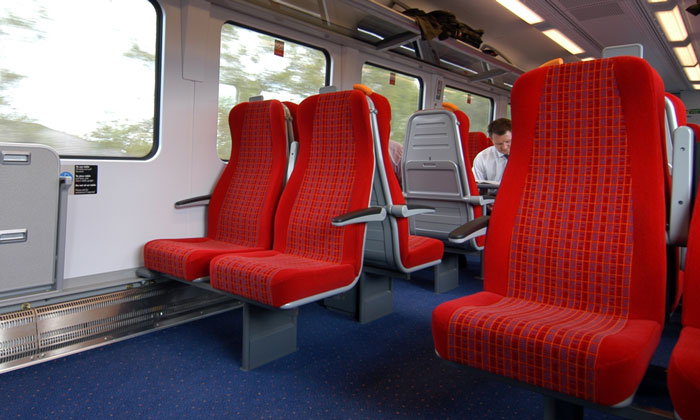Scientific approach is needed to increase passenger comfort
Posted: 21 February 2018 | Global Railway Review | 4 comments
The rail sector has decided train seat design requires scientific research to be able to provide a more informed approach to making seats both comfortable and safe for passengers…


The UK rail industry body RSSB has stated that there is an opportunity to develop a more scientific approach to measuring and delivering comfort and safety in train seats.
The new research aims to develop a more sophisticated, ‘human factor’ approach to understanding comfort, considering the shape of the seat, cushioning, material choice, lumbar spine support, vibration, leg-room, the length of the journey and other aspects.
Train operating companies, owning groups, rolling stock owning companies, suppliers and seat design manufacturers recently announced their support for the work to start and have expressed a desire to move forward with the improvements.
The goal is to create a seat comfort specification with minimum requirements for manufacturers, allowing comfort to be properly considered as an essential feature, alongside other needs such as fire safety. This could help organisations involved in rolling stock procurement, such as ROSCOs and the Department for Transport.
Jordan Smith, Senior Human Factors Specialist at RSSB, explained: “There simply aren’t any reliable industry-approved measures to quantify passenger train seat comfort. The rail industry wants us to challenge that, by exploring the potential of a new specification which takes full account of the complexity of the human factors involved, and allows owners, suppliers and government procurement teams to efficiently specify and deliver seating in line with passenger comfort.”
Related topics
Infrastructure Developments, Passenger Experience/Satisfaction, Rolling Stock Orders/Developments









Fainsa
DfT
Hideously uncomfortable seats in the class “700”
Bit late now, isn’t it?
(P.S. Longitudinal seats in TfL inner-suburban units, especially “good” for people with back, neck or hip pains. )
A ‘badly maintained’ seat would have to be in a dire condition for passengers not to use it, and prefer to stand instead, so that’s probably not a major concern for operators.
In 2010 I went all the way by train from Barnstaple in the UK to Kaunas in Lithuania. Even the wooden benches in the ex-Soviet DR1A from Šeštokiai to Kaunas were not as uncomfortable as the seats in the Class 142 Pacer from Barnstaple to Exeter and the Eurostar from St Pancras to Bruxelles. That last really surprised me; my back ache started almost as soon as I got into the seat, and no amount of twisting around eased my pain. That was a complete contrast to the next train, a Thalys from Bruxelles to Köln – the seat could not have been more comfortable. Luggage provision was totally inadequate, but that’s another story.
I was fully satisfied with the seating in the ICE from Köln to Berlin. The next stage was to Warszawa in electric loco-hauled compartment coaches as used in British Rail days. Unlike in the last days of steam here, the coaches were clean and bright, and the bench seating was comfortable. Similar, but clearly lower standard diesel-hauled corridor coaches took me on to and across the border between Poland and Lithuania where, due to change of gauge, the aforementioned DR1A completed my journey. Now, with the first stage of Rail Baltica in operation, modern standard gauge trains take you on to Kaunas.
Clearly seating is only a problem when it is noticeably uncomfortable. Of greater concern to many travellers is the relationship between seat and window – it can be infuriating not to be able to see out. That problem is often aggravated by high seat backs, and is probably the most serious consequence of the “cram in as many seats as you can” policy. I’ve seen many photos in magazines of seats too close together, but never as close as I’ve encountered in Ryanair planes. Having also done the journey between Britain and Lithuania many times by coach, I rarely complain about seats in trains, other than not enough of them, consequently I do a lot of standing in trains but never in planes or road coaches.
Hopefully a holistic approach is taken to include other factors, such as:
– fabric colours and patterns that are superior to mask minor stains.
– fabric materials that are durable yet comfortable.
– Cushion materials that can withstand ongoing cleaning activities (i.e. steam-cleaning) without deteriorating (while meeting flame retardant standards and comfort).
Transit organizations will not be able to maintain them properly if it is cost prohibitive. Ultimately, you can have the best seat but nobody will want to sit on it if it cannot be maintained.
Trouble is I think the first part of the brief is we have to cram in as many seats as possible , the ergonomics people then work with that and we end up with very uncomfortable seats , it may be the best they can do within the brief but such as the original tgv seats ,which really were comfortable , are consigned to the bin , and replaced with the sort of seats they installed on the Paris Milan route.
As for the back and bum stiffeners First group have had installed on their class 800s its obvious passenger comfort priority is at the very bottom of the list , even the first class are dreadful.